Creating a lush and vibrant garden oasis is easier than you think. With these tips and tricks, you’ll transform your green space into a serene sanctuary. Whether you have a spacious backyard or a small balcony, these ideas will help you create a beautiful and relaxing garden that you can enjoy year-round. From choosing the right plants to maximizing lighting and creating a welcoming habitat for wildlife, this article will guide you through all the steps to create your own garden oasis.
Key Takeaways:
- Choose native plants for your garden oasis, as they are better adapted to the local climate and require less maintenance.
- Maximize lighting by placing your plants near windows or using artificial lighting sources like LED grow lights.
- Water your plants with care, avoiding overwatering and ensuring proper hydration for healthy growth.
- Create a welcoming habitat for wildlife by using native plants and incorporating features like bird feeders and butterfly-friendly flowers.
- Design your garden oasis for relaxation by incorporating elements like comfortable seating areas and a peaceful atmosphere.
- Maintain your garden oasis by regularly pruning your plants, keeping an eye out for pests and diseases, and embracing organic gardening practices.
- Enhance your garden oasis with landscaping elements like flower beds and garden features to add visual interest and beauty.
- Grow your own vegetables in your garden oasis for a sustainable and rewarding experience.
- Embrace organic gardening practices to create a chemical-free and environmentally-friendly garden oasis.
Create your own garden oasis and enjoy the beauty and tranquility of nature right in your own backyard or balcony. With these tips and tricks, you’ll have a green space that brings joy and serenity to your life.
Choosing the Right Plants for Your Oasis
The key to a thriving garden oasis starts with selecting the perfect plants that will thrive in your local climate and require minimal upkeep. When it comes to choosing plants for your garden, it’s important to consider native species and low-maintenance options. Native plants are well-adapted to the local climate and soil conditions, making them more resilient and easier to care for. They also provide essential habitats for wildlife, such as birds and butterflies.
Avoid exotic varieties that may require excessive watering or special care. Instead, opt for plants that are well-suited to your region. This will not only save you time and effort but also promote a healthier ecosystem in your garden.
Here are some popular choices for native and low-maintenance plants:
| Native Plants | Low-Maintenance Plants |
|---|---|
| Dogwood | Succulents |
| Maples | Spider plants |
| Douglas firs | Peace lilies |
| Redwoods | Orchids |
By choosing native species and low-maintenance plants, you’ll be able to create a beautiful and sustainable garden oasis that requires minimal effort to maintain. These plants will not only thrive in your local climate but also attract and support local wildlife.
“The beauty of native plants is that they are perfectly adapted to the local environment, requiring less water, fertilizer, and pesticides.”
Creating a Sustainable Garden
In addition to selecting the right plants, it’s important to create a sustainable garden by implementing eco-friendly practices. This includes conserving water, reducing chemical use, and promoting biodiversity. By adopting these sustainable practices, you can further enhance the health and beauty of your garden oasis.
- Conserve water by using efficient watering techniques, such as drip irrigation or installing rainwater harvesting systems.
- Avoid chemical pesticides and fertilizers by using organic alternatives and practicing integrated pest management.
- Provide habitats for beneficial insects, birds, and other wildlife by incorporating native plants and creating wildlife-friendly features like bird feeders and butterfly gardens.
- Compost your garden waste to reduce landfill waste and create nutrient-rich soil for your plants.
By following these sustainable gardening practices, you’ll not only create a thriving garden oasis but also contribute to a healthier environment.
In conclusion, choosing the right plants for your garden oasis is crucial for its long-term success. By selecting native species and low-maintenance plants, you’ll create a beautiful and sustainable garden that thrives in your local climate. Remember to also incorporate sustainable gardening practices to further enhance the health and beauty of your oasis. Happy gardening!
Providing your plants with the right amount of light is crucial for their growth and overall health. Learn how to make the most of natural and artificial lighting in your garden oasis.
When it comes to creating a thriving garden oasis, lighting is a key factor to consider. Plants need sufficient light for photosynthesis, which is essential for their growth and development. By utilizing natural and artificial lighting effectively, you can ensure that your plants receive the light they need to flourish.
Maximizing Natural Light
Natural light is the ideal source of light for your plants, as it provides a full spectrum of wavelengths that they require. Here are some tips for maximizing natural light in your garden:
- Place your garden in a location that receives ample sunlight throughout the day, avoiding areas that are heavily shaded by buildings or trees.
- Consider the orientation of your garden. South-facing gardens typically receive the most sunlight, while north-facing gardens may require additional lighting.
- Utilize reflective surfaces, such as white walls or mirrors, to redirect and amplify natural light towards your plants.
Remember to regularly monitor the light conditions in your garden, as they can change throughout the day and depending on the season. Adjust the positioning of your plants accordingly to ensure they receive optimal light exposure.
Using Artificial Lighting
In situations where natural light is limited or inconsistent, artificial lighting can be a valuable supplement for your plants. Here are some considerations for using artificial lighting effectively:
- Choose the right type of artificial lighting for your plants. LED grow lights and fluorescent lights are popular choices due to their energy efficiency and suitability for a variety of plant species.
- Position the lights at the appropriate distance from your plants to ensure even light distribution. Refer to the manufacturer’s instructions for recommended distances.
- Adapt the light intensity and duration based on the specific needs of your plants. Different plant species have varying light requirements, so it’s important to tailor the lighting accordingly.
By properly utilizing artificial lighting, you can create a consistent light source for your plants, especially during periods of low natural light or in indoor garden settings.
Light is essential for the growth of your indoor plants. Place them near windows or in areas with sufficient natural light.” – Expert Gardener
Conclusion
Proper lighting is a crucial aspect of creating a green oasis in your garden. By maximizing natural light and using artificial lighting effectively, you can provide your plants with the optimal light conditions they need to thrive. Remember to monitor and adjust the lighting as necessary to ensure the health and growth of your plants. With adequate lighting, your garden oasis will flourish with beauty and vitality.
Proper watering is vital for the health and vitality of your plants. Discover the best techniques to keep your garden oasis lush and thriving.
Watering your garden properly is essential for the overall well-being of your plants. By following the right techniques, you can ensure that your garden oasis remains healthy and vibrant. Here are some tips to help you achieve optimal plant hydration:
- Watering frequency: The frequency of watering will depend on several factors such as the type of plants, soil type, and weather conditions. As a general rule, it’s best to water deeply and infrequently rather than shallowly and frequently. This allows the water to penetrate the soil and reach the roots, promoting stronger and healthier plants.
- Watering in the morning: It’s ideal to water your garden in the morning, as this allows the plants to absorb moisture before the heat of the day evaporates it. Watering in the evening can lead to prolonged moisture on the leaves, which can create a favorable environment for disease.
- Watering at the base: When watering, direct the water at the base of the plants rather than overhead. This helps minimize water waste and ensures that the roots receive the necessary moisture.
- Deep watering: When you do water, make sure to provide a deep soaking. This encourages the roots to grow deeper into the soil, resulting in stronger and more drought-tolerant plants. Aim to wet the soil to a depth of at least 6 inches.
- Monitoring soil moisture: Regularly check the moisture level of the soil to determine when to water. You can do this by sticking your finger into the soil or using a moisture meter. If the top inch of soil feels dry, it’s time to water.
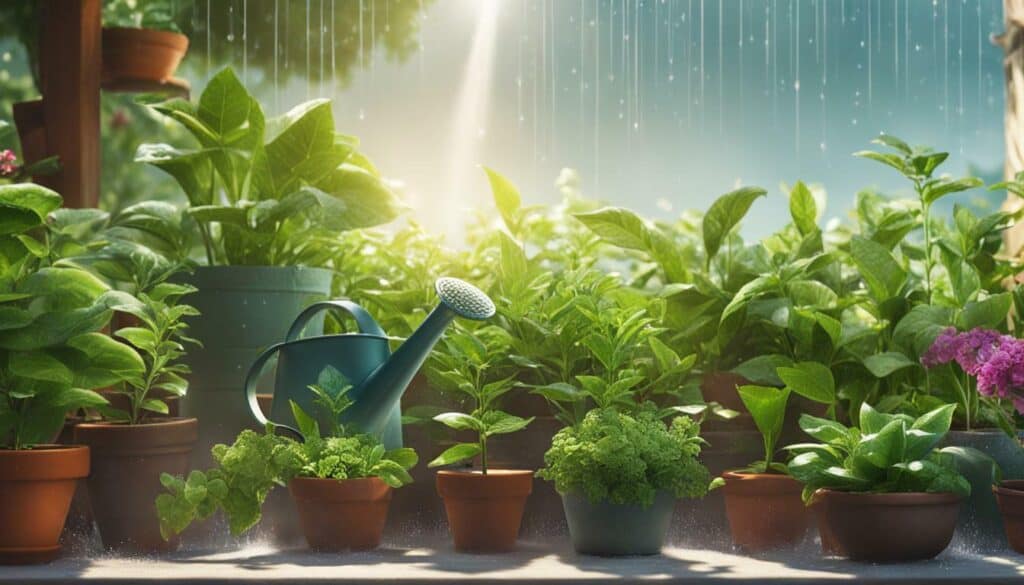
Remember that different plants have different water requirements. Some may prefer drier conditions, while others need consistent moisture. Understanding the needs of your individual plants will help you tailor your watering routine accordingly.
“Watering deeply and infrequently promotes stronger and healthier plants.”
Additionally, consider implementing water-saving techniques to conserve water and minimize waste. These include using mulch to retain moisture, grouping plants with similar watering needs together, and installing a drip irrigation system to deliver water directly to the roots.
Proper watering is the key to a thriving garden oasis
Ensuring that your garden oasis receives adequate hydration is crucial for its long-term success. By following these proper watering techniques, you can create a lush and vibrant outdoor space. Remember to monitor the soil moisture, water deeply and infrequently, and tailor your watering routine to each plant’s specific needs. With a little care and attention, your garden oasis will flourish and provide a beautiful sanctuary for you to enjoy.
Creating a Welcoming Habitat for Wildlife
Transform your garden oasis into a haven for wildlife by incorporating native plants and creating ideal habitats for birds and butterflies. By following these tips, you can attract a variety of beautiful and beneficial creatures to your garden.
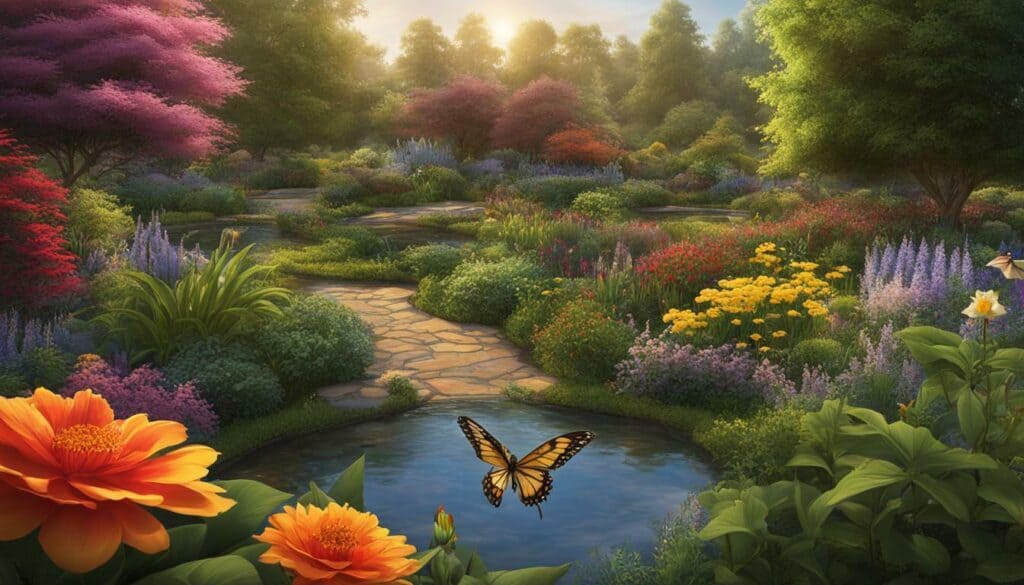
Attracting Birds and Butterflies
Birds and butterflies are not only lovely to observe, but they also play important roles in pollination and pest control. To attract these winged wonders to your garden, choose plants that provide nectar, pollen, and shelter.
Native plants are particularly effective in attracting birds and butterflies, as they have evolved alongside these creatures and provide the resources they need to thrive. Consider planting species such as milkweed, coneflowers, and butterfly bush, which are known to be favorites among butterflies. For birds, opt for plants with berries or nectar-rich flowers, such as sunflowers, cardinal flowers, and serviceberries.
Creating Native Plant Habitats
Native plants not only attract wildlife but also provide essential habitats for them to thrive. Create diverse landscapes within your garden by incorporating a variety of native plants that provide food and shelter.
Group plants together based on their water and sunlight needs to create microhabitats that simulate natural ecosystems. This will encourage a greater diversity of wildlife to visit and take up residence in your garden. For example, plant taller shrubs and trees along the perimeter to provide nesting sites and cover, while ground-level plants can offer food sources and hiding places.
Providing Food and Water Sources
Supplying food and water sources is essential for attracting and supporting wildlife in your garden. Install bird feeders with a variety of seed types to cater to different bird species. Place bird baths or shallow dishes filled with fresh water in easily accessible locations, ensuring they are regularly cleaned and refilled.
Consider incorporating a small pond or water feature, as it can serve as a valuable freshwater source for birds, butterflies, and other wildlife. Add floating plants and rocks to provide resting spots and natural filtration for the water.
Creating Shelter and Nesting Sites
“The well-being of wildlife in your garden depends on the availability of suitable shelter and nesting sites.”
Provide various types of shelter for wildlife, including birdhouses, nesting boxes, and bat boxes. These structures mimic natural cavities that many species rely on for nesting and roosting. Place them at different heights throughout your garden to accommodate the needs of different species.
Leave dead trees or standing snags in your garden, as they provide valuable nesting sites for cavity-nesting birds and shelter for a variety of insects. Fallen logs and brush piles can offer refuge to small mammals, reptiles, and amphibians.
Encouraging Sustainable Gardening Practices
Opt for sustainable gardening practices to ensure the well-being of wildlife in your garden. Avoid using chemical pesticides, herbicides, and fertilizers, as they can harm beneficial insects and disrupt the delicate balance of your garden ecosystem. Instead, embrace organic gardening methods and rely on natural pest control measures.
Regularly maintain and clean your garden by removing debris, fallen leaves, and weeds. This reduces hiding places for unwanted pests and helps prevent the spread of diseases. By maintaining a clean and healthy garden environment, you create a more inviting space for wildlife.
With these tips, you can create a garden oasis that not only provides beauty and tranquility but also serves as a thriving habitat for birds and butterflies. By incorporating native plants, providing food and water sources, and creating shelter and nesting sites, you can attract a diverse range of wildlife to your garden and contribute to the conservation of local species.
“`html
Designing Your Garden Oasis for Relaxation
Design your garden oasis with relaxation in mind, creating a peaceful retreat where you can escape the stresses of everyday life. Whether you have a small balcony or a large backyard, incorporating elements that promote tranquility and serenity can transform your outdoor space into a haven of calm.
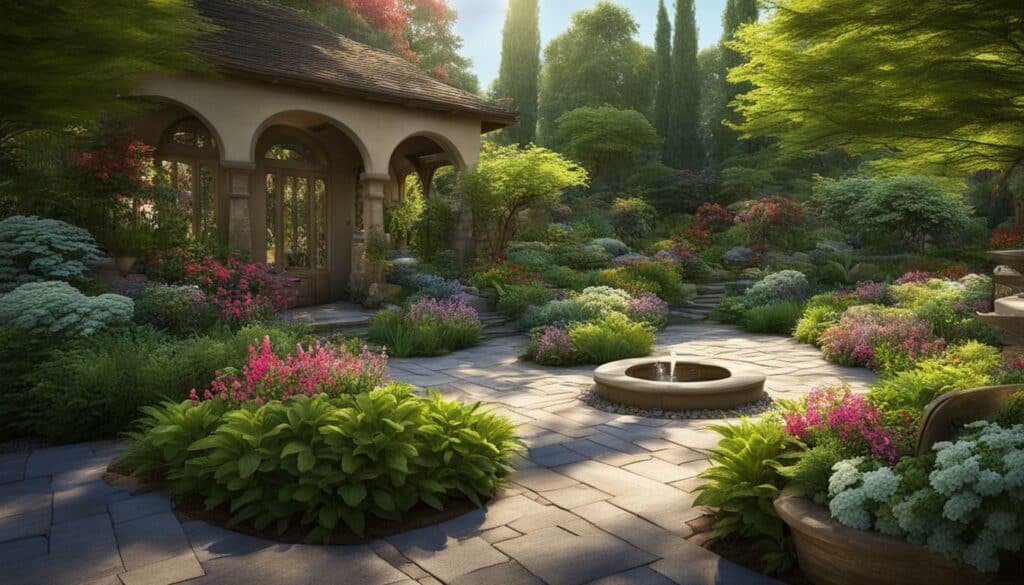
Choosing the Right Plants
When designing your garden oasis for relaxation, selecting the right plants is key. Opt for species that have calming scents, such as lavender or jasmine, to create a soothing environment. Incorporate a variety of textures and colors to stimulate the senses and add visual interest.
Creating a Cozy Seating Area
A comfortable seating area is essential for relaxation in your garden oasis. Choose outdoor furniture that is both inviting and durable. Soft cushions, cozy blankets, and a shady umbrella can create a cozy ambiance that encourages you to unwind and enjoy the beauty of nature.
Adding Water Features
The sound of running water can have a calming effect on the mind and body. Consider incorporating a water feature, such as a fountain or pond, into your garden oasis. The gentle trickling sound will create a peaceful atmosphere and mask any unwanted noise from the surrounding environment.
Using Natural Elements
Embrace the natural elements in your garden oasis to enhance the feeling of relaxation. Use natural materials, such as stone or wood, for pathways, seating areas, and decorative elements. Incorporate elements like fire pits or fireplaces to create a cozy ambiance during chilly evenings.
Creating Privacy
Privacy is essential for truly unwinding in your garden oasis. Consider using fencing, trellises, or planting tall bushes or trees to create a sense of seclusion. This will allow you to immerse yourself in the tranquil surroundings without feeling exposed to the outside world.
| Key Elements for a Relaxing Garden Oasis |
|---|
| Choosing calming scented plants |
| Creating a cozy seating area with comfortable furniture |
| Incorporating water features for soothing sounds |
| Using natural materials to add a touch of nature |
| Creating privacy for a sense of seclusion |
“Nature always wears the colors of the spirit.” – Ralph Waldo Emerson
- Surround yourself with calming scents
- Incorporate comfortable seating
- Add the soothing sound of water
- Use natural materials
- Create a private and secluded space
Designing your garden oasis with relaxation in mind requires careful consideration of plants, furniture, and elements that promote peace and tranquility. By incorporating these elements, you can create a peaceful retreat where you can unwind and find solace in the beauty of nature.
“`
Section 7: Maintaining Your Garden Oasis
Keeping your garden oasis in pristine condition requires regular maintenance and proper plant care. Discover the best techniques for maintaining your green sanctuary.
Proper maintenance and care are essential for ensuring the long-term health and beauty of your garden. Here are some key tips and techniques for maintaining your garden oasis:
- Regular Watering: Proper watering is crucial for plant health. Ensure your plants receive adequate hydration by watering them deeply and consistently. Avoid overwatering, as it can lead to root rot and other moisture-related issues. Use a watering can or a hose with a nozzle attachment to provide a gentle and even distribution of water.
- Pruning Techniques: Regular pruning helps maintain the shape, size, and overall health of your plants. Remove any dead, damaged, or diseased branches, leaves, or flowers. Use clean and sharp pruning tools to make clean cuts, and always prune plants during their appropriate growing season to avoid unnecessary stress.
- Fertilizing: Provide essential nutrients to your plants by fertilizing them regularly. Choose a balanced, water-soluble fertilizer and apply it according to the instructions provided. Be careful not to over-fertilize, as it can lead to salt buildup and damage the roots. Consider using organic fertilizers to promote sustainable gardening practices.
- Weed Control: Keep your garden oasis free from weeds by regularly removing them. Pull weeds by hand or use a hoe or garden tool to eliminate them. Mulching can also help suppress weed growth and conserve moisture in the soil. Apply a layer of organic mulch, such as wood chips or leaves, around your plants to deter weeds and enhance the overall appearance of your garden.
- Pest and Disease Management: Protect your plants from pests and diseases by implementing proactive measures. Monitor your garden regularly for any signs of infestation or disease, such as chewed leaves or discolored foliage. If you spot any issues, take immediate action using organic pest control methods or seek advice from a gardening professional. Remember to practice good hygiene by cleaning your tools and equipment to prevent the spread of diseases.
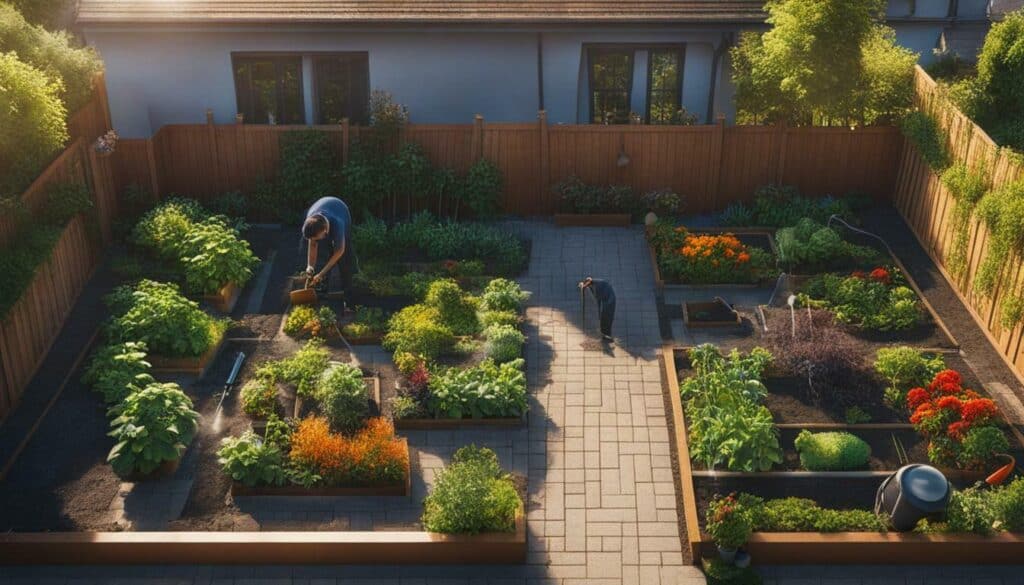
“Regular maintenance and care are essential for ensuring the long-term health and beauty of your garden.”
By following these maintenance techniques and providing proper care for your plants, you can keep your garden oasis thriving all year round. Remember to stay attentive to your plants’ needs, adapt your maintenance routine to the changing seasons, and enjoy the rewards of a well-maintained green sanctuary.
Dealing with Garden Pests and Diseases
Don’t let garden pests and diseases spoil the peace and beauty of your oasis. Learn how to identify and combat common issues using organic pest control methods.
Garden pests and diseases can wreak havoc on your plants, causing damage and hindering their growth. However, with the right knowledge and organic pest control methods, you can protect your garden oasis and keep it thriving. Here are some effective strategies to tackle garden pests and diseases:
| Pest or Disease | Description | Organic Pest Control Methods |
|---|---|---|
| 1. Aphids | Aphids are small, soft-bodied insects that suck sap from your plants, causing stunted growth and distorted leaves. | – Introduce beneficial insects like ladybugs and lacewings that feed on aphids. – Use a homemade organic spray made from neem oil, garlic, or soapy water to repel aphids. – Remove heavily infested leaves or plants to prevent further spread. |
| 2. Slugs and Snails | Slugs and snails are common garden pests that feed on leaves, seedlings, and flowers, leaving behind slimy trails. | – Set up beer traps by burying containers filled with beer in the soil to attract and drown slugs and snails. – Place copper barriers around susceptible plants to repel these pests. – Handpick slugs and snails in the evening when they are most active. |
| 3. Fungal Diseases | Fungal diseases like powdery mildew and leaf spot can thrive in warm and humid conditions, causing leaf discoloration and decay. | – Provide adequate air circulation by spacing plants properly and pruning overcrowded branches. – Water plants at the base to avoid wetting the leaves, as moisture can promote fungal growth. – Apply organic fungicides containing neem oil, copper, or sulfur to control fungal diseases. |
| 4. Caterpillars | Caterpillars, the larval stage of butterflies and moths, can devour leaves and young shoots, causing extensive damage. | – Encourage natural predators like birds and beneficial insects that feed on caterpillars. – Use organic Bacillus thuringiensis (Bt) insecticide, which targets caterpillars specifically. – Handpick caterpillars and remove them from your plants. |
Remember, prevention is key to maintaining a healthy garden oasis. Regularly inspect your plants for signs of pests and diseases, and take immediate action to prevent the problem from spreading.
In addition to organic pest control methods, it’s important to follow good gardening practices to promote a strong and resilient garden:
- Properly space your plants to allow for adequate airflow and reduce the risk of disease.
- Water your plants at the base to avoid wetting the foliage, as moisture can promote the growth of fungal diseases.
- Remove any dead or diseased plant material to prevent pests and diseases from spreading.
- Maintain healthy soil by adding organic matter and using compost to improve its fertility and drainage.
- Rotate your crops each year to minimize the risk of recurring pests and diseases.
By implementing these organic pest control methods and practicing good gardening habits, you can create a thriving and pest-free oasis in your garden. Remember, prevention and early intervention are key to keeping your plants healthy and enjoying a beautiful and harmonious outdoor space.
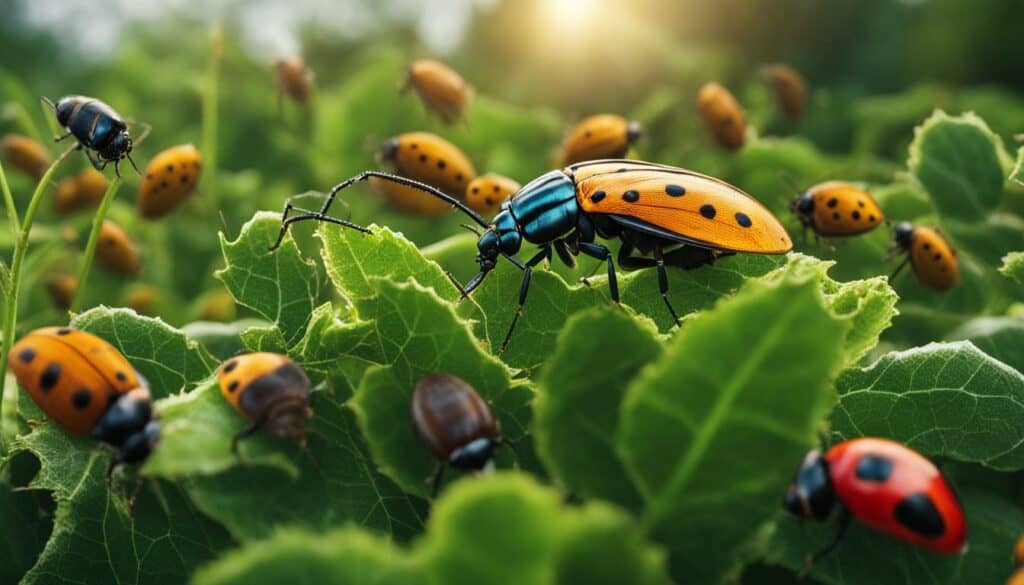
Next up: Section 9 – Embracing Organic Gardening in Your Oasis
Enhancing Your Garden Oasis with Organic Gardening
Enhance the beauty and sustainability of your garden oasis by embracing organic gardening practices that promote a healthier environment for both plants and people. Organic gardening involves growing plants without the use of synthetic chemicals, pesticides, or fertilizers. By eliminating these harmful substances from your gardening routine, you not only create a safe space for your plants to thrive but also contribute to the overall well-being of the ecosystem.
Organic gardening practices offer numerous benefits, including:
- Minimizing exposure to harmful chemicals
- Preserving soil health and fertility
- Promoting biodiversity and supporting beneficial insects and pollinators
- Reducing environmental pollution
- Producing healthier and more nutritious fruits and vegetables
To get started with organic gardening in your garden oasis, consider implementing the following sustainable practices:
- Compost: Create your own compost by recycling kitchen scraps, yard waste, and fallen leaves. Compost adds nutrients to the soil, improves its structure, and enhances moisture retention.
- Crop Rotation: Rotate your plantings each year to prevent the buildup of pests and diseases. This practice helps maintain a healthy balance in the soil and reduces the need for chemical interventions.
- Beneficial Insects: Attract beneficial insects such as ladybugs, lacewings, and bees to your garden by planting flowers that provide nectar and pollen. These insects help control pests naturally, reducing the need for chemical pesticides.
- Natural Pest Control: Use organic pest control methods such as neem oil, insecticidal soaps, or companion planting to deter pests and keep your garden free from harmful chemicals.
- Water Conservation: Install a rain barrel to collect rainwater for irrigation. This reduces water consumption and ensures a sustainable water supply for your plants.
- Mulching: Apply a layer of organic mulch around your plants to suppress weeds, retain moisture, and regulate soil temperature. Mulch also enriches the soil as it decomposes.
- Cover Cropping: Plant cover crops during fall or winter to protect and nourish the soil. Cover crops improve soil structure, prevent erosion, and add organic matter.
- Integrated Pest Management: Implement an integrated pest management (IPM) approach that focuses on prevention, monitoring, and using natural pest control methods as the first line of defense against pests and diseases.
By incorporating these organic gardening practices into your garden oasis, you can create a sustainable and vibrant environment that harmonizes with nature. Remember, organic gardening is not only about growing plants; it’s about nurturing a thriving ecosystem that supports the well-being of all living things.
Organic Gardening: A Holistic Approach to Garden Care
Organic gardening is more than just avoiding synthetic chemicals; it’s a holistic approach to garden care that prioritizes the health and well-being of the entire ecosystem. By embracing organic gardening practices, you are not only creating a beautiful and sustainable garden oasis, but also contributing to a greener and healthier planet.
“The greatest gift of the garden is the restoration of the five senses.”
– Hanna Rion
Enhancing Your Garden Oasis with Landscaping Elements
Take your garden oasis to the next level by incorporating beautiful landscaping elements that will elevate the aesthetics and ambiance of your green space. Whether you have a small backyard or a spacious garden, these ideas will help transform your outdoor area into a stunning oasis that you can enjoy year-round.
1. Create Flower Beds:
Add vibrant colors and textures to your garden oasis by creating flower beds. Choose a variety of flowers that bloom at different times of the year to ensure continuous blooms and visual interest. Planting flowers in clusters or rows can create a dramatic effect, while incorporating a mix of annuals and perennials will provide long-lasting beauty. You can use stone borders or wooden edges to define the flower beds and add a touch of elegance to your garden.
2. Install Garden Features:
Add eye-catching focal points to your garden oasis by installing various garden features. Consider adding a water fountain or pond to create a soothing atmosphere and attract birds and butterflies. Sculptures, decorative garden stakes, and trellises can also add visual interest and serve as unique conversation pieces. Choose features that complement your garden’s style and create a harmonious blend with the surrounding plants and landscaping.

3. Incorporate Pathways:
Add charm and functionality to your garden oasis by incorporating pathways. You can use materials such as flagstone, pebble, or brick pavers to create inviting walkways that meander through your garden. Pathways not only enhance the visual appeal of your garden but also provide a practical way to navigate and explore your outdoor space. Consider adding accent lighting along the pathways to create a magical ambiance during the evening hours.
4. Integrate Outdoor Seating:
Create a cozy and relaxing atmosphere in your garden oasis by integrating outdoor seating areas. Whether it’s a comfortable garden bench, a swing chair, or a secluded seating nook, having a designated area to sit and enjoy your garden will enhance your overall experience. Choose seating options that are weather-resistant and comfortable, and arrange them strategically to take advantage of beautiful views or create intimate spaces.
5. Add Garden Lighting:
Extend the enjoyment of your garden oasis into the evening by adding garden lighting. Use solar-powered or LED lights to illuminate pathways, highlight specific plants or features, and create a warm and inviting ambiance. Lighting can not only enhance the beauty of your garden but also provide necessary safety and security. Consider installing uplights to showcase trees or architectural features, or string lights to create a cozy atmosphere for outdoor gatherings.
Creating a garden oasis with beautiful landscaping elements allows you to personalize your outdoor space and create a tranquil retreat that reflects your style and taste. Whether you choose to incorporate flower beds, garden features, pathways, outdoor seating, or garden lighting, each element will contribute to the overall beauty and ambiance of your garden oasis.
| Benefits of Landscaping Elements in Your Garden Oasis |
|---|
| Create vibrant colors and textures |
| Add eye-catching focal points |
| Enhance the functionality of your garden |
| Create a cozy and relaxing atmosphere |
| Extend the enjoyment into the evening |
As you design and incorporate these landscaping elements into your garden oasis, remember to consider the overall layout, balance, and harmony. By thoughtfully selecting and placing these elements, you can create a cohesive and visually stunning outdoor space that you can enjoy and take pride in.
Growing Your Own Vegetables in the Garden Oasis
Add a fresh and delicious element to your garden oasis by growing your own vegetables. Discover the joys of vegetable gardening and enjoy homegrown produce.
When it comes to creating a green oasis in your garden, growing your own vegetables can be a rewarding and satisfying experience. Not only will you have access to fresh and nutritious produce, but you’ll also have the opportunity to connect with nature and nurture your green thumb.
Here are some important tips to help you get started with vegetable gardening in your garden oasis:
- Choose the Right Vegetables: Select vegetables that are well-suited to your climate and growing conditions. Consider factors such as sunlight requirements, soil type, and available space. Some popular choices for beginners include tomatoes, lettuce, peppers, and herbs like basil and parsley.
- Prepare the Soil: Before planting, make sure to prepare the soil by removing any weeds and loosening it with a garden fork or tiller. Incorporate organic matter like compost or well-rotted manure to improve soil fertility and drainage.
- Plan Your Garden Layout: Design a layout that optimizes space and promotes healthy growth. Consider the height and spread of each vegetable plant and leave enough room for proper air circulation. Group plants with similar watering and sunlight requirements together.
- Planting and Watering: Follow the planting instructions on the seed packets or plant labels. Ensure that each vegetable is planted at the appropriate depth and spacing. Water your garden regularly, providing adequate moisture without overwatering. Use a watering can or drip irrigation system to target the base of the plants and avoid wetting the foliage.
- Nurture Your Plants: Monitor your vegetable garden closely and address any issues promptly. Remove weeds regularly to reduce competition for nutrients and water. Apply organic mulch around the plants to suppress weeds, retain moisture, and regulate soil temperature.
- Protect Your Garden: Keep an eye out for pests and diseases that can harm your vegetable plants. Use organic pest control methods such as companion planting, handpicking pests, or using natural repellents. Regularly inspect your plants for signs of disease and take appropriate measures to prevent spread.
- Harvesting: Harvest your vegetables at their peak ripeness to enjoy their full flavor. Follow specific guidelines for each vegetable, as harvesting times can vary. Remember to harvest regularly to encourage continuous production and prevent overripe or spoiled crops.
- Enjoy the Fruits of Your Labor: Once you’ve harvested your vegetables, savor the satisfaction of enjoying homegrown produce. Use your freshly picked vegetables in delicious recipes, share them with friends and neighbors, or preserve them for future use.
By growing your own vegetables in your garden oasis, you’ll not only enhance the beauty of your space but also reap the rewards of your hard work. So roll up your sleeves, get your hands dirty, and watch your vegetable garden thrive!
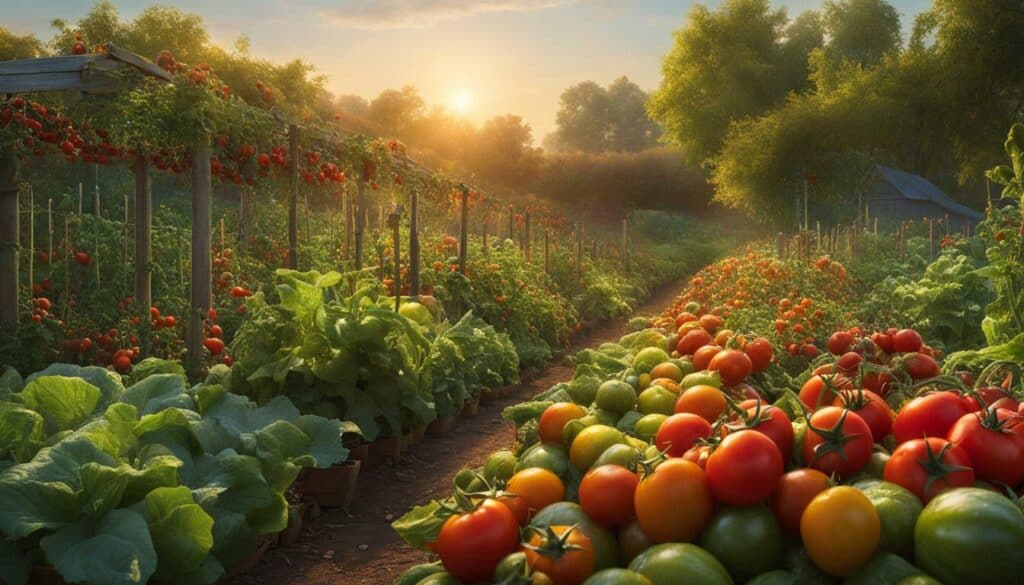
“The glory of gardening: hands in the dirt, head in the sun, heart with nature. To nurture a garden is to feed not just the body, but the soul.” – Alfred Austin
Conclusion
Creating a garden oasis is a rewarding endeavor that brings beauty, tranquility, and a touch of nature to your outdoor space. With these tips and tricks, you’re well-equipped to make your garden a green oasis.
First and foremost, selecting the right plants is key to creating a thriving garden oasis. Choose native species and low-maintenance plants that will thrive in your specific climate and conditions. This will ensure that your garden is not only beautiful, but also sustainable and easy to care for.
In addition to choosing the right plants, maximizing lighting is essential for optimal growth. Take advantage of natural light by placing your garden in a sunny spot and consider supplementing with artificial lighting if needed. Adequate lighting will help your plants flourish and create a vibrant oasis.
Proper watering techniques are crucial for maintaining healthy plants in your garden oasis. Avoid overwatering by watering your plants when the topsoil feels dry to the touch. Use a watering can or spray bottle to ensure gentle and even distribution of water, and consider misting the leaves of tropical plants to maintain humidity levels.
Creating a welcoming habitat for wildlife is not only beneficial for the environment, but also adds to the charm of your garden oasis. Incorporate native plants that attract birds and butterflies, and provide food and shelter for these creatures. By inviting wildlife into your garden oasis, you’ll create a harmonious and vibrant ecosystem.
Designing your garden oasis for relaxation is essential for creating a peaceful retreat. Consider incorporating elements such as comfortable seating areas, soothing water features, and fragrant flowers to create a serene atmosphere. By designing your garden with relaxation in mind, you’ll be able to fully enjoy the tranquility of your outdoor space.
Maintaining your garden oasis is key to its long-term beauty and health. Regularly prune and care for your plants to promote new growth and prevent the spread of diseases. Additionally, stay vigilant against garden pests and diseases by inspecting your plants regularly and using organic pest control methods when necessary.
Embracing organic gardening practices in your garden oasis not only benefits the environment, but also promotes the health of your plants and the quality of your produce. Avoid chemicals and synthetic fertilizers and opt for sustainable practices such as composting and natural pest control methods. By adopting organic gardening, you’ll create a healthier and more eco-friendly garden oasis.
Enhancing your garden oasis with landscaping elements adds visual interest and creates focal points in your outdoor space. Consider adding flower beds, garden features, and decorative elements to enhance the overall aesthetic of your garden oasis. By incorporating landscaping elements, you’ll transform your garden into a truly enchanting oasis.
Growing your own vegetables in your garden oasis not only provides you with fresh, homegrown produce, but also adds to the beauty and functionality of your outdoor space. Select vegetable varieties that thrive in your climate and follow best practices for successful vegetable gardening. By growing your own vegetables, you’ll have a bountiful and delicious addition to your garden oasis.
In conclusion, creating a garden oasis is a rewarding and fulfilling endeavor that allows you to connect with nature and create a peaceful retreat in your outdoor space. By following these tips and tricks, you’ll be well on your way to transforming your garden into a green oasis that brings joy and serenity to your life.
FAQ
Q: How do I choose the right plants for my garden oasis?
A: It’s important to consider factors such as lighting conditions, temperature, and humidity levels in your home. Opt for low-maintenance plants like succulents or peace lilies if you’re a beginner. Native species are also a great choice as they are better adapted to the local climate.
Q: How can I ensure adequate lighting for my plants?
A: Place your plants near windows or use artificial lighting sources like fluorescent or LED grow lights. Adjust the light intensity and duration based on your plants’ specific needs.
Q: What are some essential watering techniques for healthy plants?
A: Avoid overwatering your plants and water them when the topsoil feels dry to the touch. Use a watering can or spray bottle for gentle and even distribution of water. Misting the leaves of tropical plants can help maintain the desired humidity levels.
Q: How can I create a welcoming habitat for wildlife in my garden oasis?
A: Plant native species, which provide essential habitats for birds and butterflies. Consider adding water features like birdbaths, ponds, or fountains to attract aquatic creatures.
Q: What are some design tips for creating a relaxing garden oasis?
A: Group similar plants together for a big visual impact and consider adding elements like trees, shrubs, or water features. Create focal points with colorful blooms or surround your favorite tree or shrub with a sea of flowers.
Q: How do I maintain my garden oasis?
A: Regularly prune and maintain your plants by removing dead leaves, stems, and flowers. Dust the leaves to keep them clean and maintain proper air circulation. Stay vigilant against pests and diseases by inspecting your plants regularly.
Q: What are some organic pest control methods for my garden oasis?
A: Isolate affected plants and treat them with appropriate organic solutions. Maintain cleanliness and provide proper plant care to prevent pests and diseases. Rotate your plants to ensure balanced growth.
Q: What are the advantages of organic gardening in my garden oasis?
A: Organic gardening practices promote sustainability and chemical-free gardening. They are better for the environment and can result in healthier plants and produce.
Q: How can I enhance my garden oasis with landscaping elements?
A: Consider adding flower beds, garden features, or other landscaping elements to enhance the beauty of your garden oasis. Group plants together and create focal points to create visual interest.
Q: How do I grow my own vegetables in the garden oasis?
A: Choose suitable vegetable varieties for your garden oasis and provide them with the right growing conditions. Follow proper planting and care techniques to ensure successful vegetable gardening in your oasis.
How Can I Create a Serene Sanctuary in My Garden?
By incorporating elements of nature, like soothing water features and lush greenery, you can effortlessly embrace the garden’s personal sanctuary. Create a cozy seating area amidst colorful flowers or set up a hammock under a shady tree for relaxation. Add aromatic plants to awaken the senses and indulge in the calming ambiance of your serene outdoor haven.





Leave a Reply